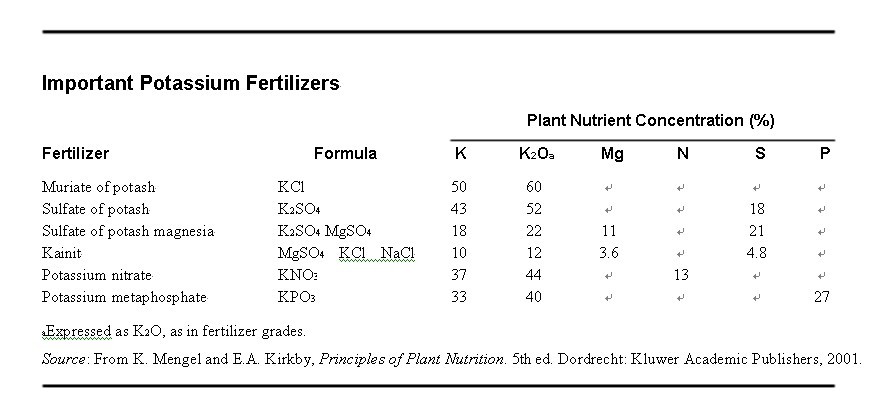|
|
|
K element and Potassium Nutrition |
| Author : Doctor Liu Date : 8/8/2011 6:52:18 AM |
SYMPTOMS OF DEFICIENCY
The beginning of K deficiency in plants is growth retardation, which is a rather nonspecific symptom and is thus not easily recognized as K deficiency. The growth rate of internodes is affected , and some dicotyledonous species may form rosettes . With the advance of K deficiency, old leaves show the first symptoms as under such conditions K is translocated from older to younger leaves and growing tips via the phloem. In most plant species, the older leaves show chlorotic and necrotic symptoms as small stripes along the leaf margins, beginning at the tips and enlarging along leaf margins in the basal direction. This type of symptom is particularly typical for monocotyledonous species. The leaf margins are especially low in K , and for this reason, they lose turgor, and the leaves appear flaccid. This symptom is particularly obvious in cases of a critical water supply. In some plant species, e.g., white clover (Trifolium repens L.), white and necrotic spots appear in the intercostal areas of mature leaves, and frequently, these areas are curved in an upward direction. Such symptoms result from a shrinkage and death of cells because of an insufficient turgor. Growth and differentiation of xylem and phloem tissue is hampered more than the growth of the cortex. Thus, the stability and elasticity of stems is reduced so that plants are more prone to lodging . In tomato (Lycopersicon esculentum Mill.) fruits insufficiently supplied with K , maturation is disturbed, and the tissue around the fruit stem remains hard and green . The symptom is called greenback and it has a severe negative impact on the quality of tomato.
At an advanced stage of K deficiency, chloroplasts and mitochondria collapse . Potassium-deficient plants have a low-energy status because, as shown above, K is essential for efficient energy transfer in chloroplasts and mitochondria. This deficiency has an impact on numerous synthetic processes, such as synthesis of sugar and starch, lipids, and ascorbate and also on the formation of leaf cuticles. The latter are poorly developed under K deficiency . Cuticles protect plants against water loss and infection by fungi. This poor development of cuticles is one reason why plants suffering from insufficient K have a high water demand and a poor water use efficiency (WUE, grams of fresh beet root matter per grams of water consumed). Sugar beet grown with insufficient K , and therefore showing typical K deficiency, had a WUE of 5.5. Beet plants with a better, but not yet optimum, K supply, and showing no visible K deficiency symptoms, had a WUE of 13.1, and beet plants sufficiently supplied with K had a WUE of 15.4 . Analogous results were found for wheat (Triticum aestivum L.) grown in solution culture . The beneficial effect of K on reducing fungal infection has been observed by various authors . The water-economizing effect of K and its protective efficiency against fungal infection are of great ecological relevance.
SYMPTOMS OF EXCESS
Excess K in plants is rare as K uptake is regulated strictly . The oversupply of K is not characterized by specific symptoms, but it may depress plant growth and yield . Excess K supply has an impact on the uptake of other cationic species and may thus affect crop yield and crop quality. With an increase of K availability in the soil, the uptake of Mg2 and Ca2 by oats (Avena sativa L.) was reduced . This action may have a negative impact for forage, where higher Mg2 concentrations may be desirable. The relationship between K availability and the Mg2 concentrations in the aerial plant parts of oats at ear emergence is shown in Figure 4.6 . From the graph, it is clear that the plants took up high amounts of Mg2 only if the K supply was not sufficient for optimum growth. High K uptake may also hamper the uptake of Ca2 and thus contribute to the appearance of bitter pit in apple (Malus pumila Mill.) fruits and of blossom-end rot in tomato fruits, with strong adverse effects on fruit quality .

We potassium fertilizer do we have ? |
|





 NPK Fertilizer
NPK Fertilizer

